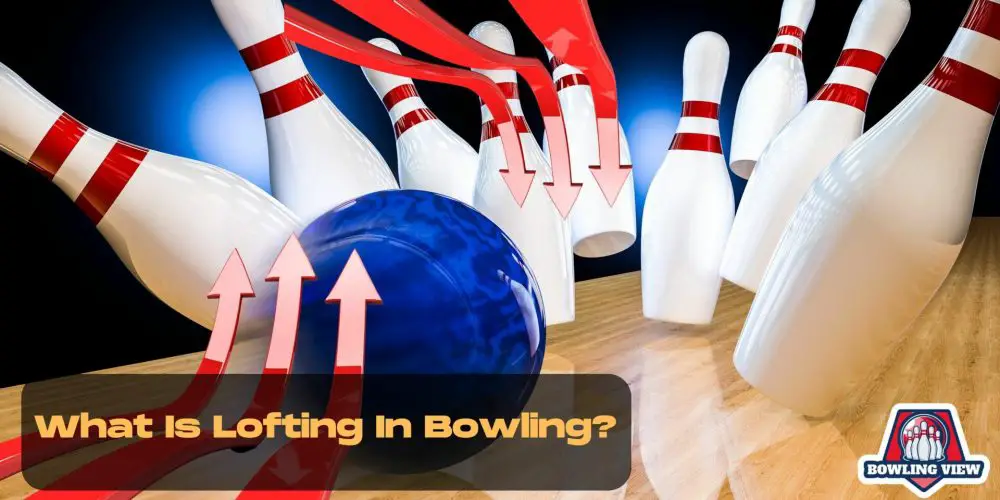Bowling is a fun and engaging sport that millions of people around the world enjoy. It’s a game that combines skill, strategy, and sometimes a little luck.
But what about the term “lofting” in bowling? Have you heard of it? Let’s delve deep into the concept of lofting in this blog post.
What is Lofting?
Have you ever heard people at the bowling alley talking about lofting? What does that mean? Lofting is when you let go of the bowling ball so it flies a bit through the air before hitting the lane. When you loft the ball, it doesn’t touch the lane immediately but spends a short time in the air.
The Purpose of Lofting
Lofting serves a specific purpose in bowling. In particular, it’s used to delay the ball’s reaction on the lane. When you release the ball directly onto the lane, it immediately begins its hook motion. However, when you loft the ball, it spends more time in the air and less in contact with the lane, thus delaying the hook.
When to Use Lofting
Lofting is usually used when bowling gets tricky because of the lane conditions. It’s beneficial when the lanes are too dry and the ball starts to turn too soon. When bowlers loft the ball, it lets them guide it better and ensures it turns just when and where they want it to.
How Lofting Works in Bowling
Let’s delve a little deeper into the science behind lofting.
The Science Behind Lofting
When you loft a ball, you alter the physics involved in its journey down the lane. Instead of letting the ball roll immediately after release, you allow it to cover some distance in the air. This aerial distance changes the ball’s trajectory and speed, impacting how and when it hooks.
Role of Lofting in Altering Ball Trajectory
When you loft the ball, you delay the hook, changing the ball’s trajectory. This can be a powerful technique when used correctly. In a nutshell, lofting manipulates the lane conditions to your advantage.
Effect of Lofting on Ball Speed
Lofting also affects the ball’s speed. Because the ball spends more time in the air, it travels faster down the lane. This increase in speed can help overcome certain lane conditions, such as heavy oil patterns that might otherwise slow the ball down.
Pros and Cons of Lofting in Bowling
Like any technique, lofting has its benefits and drawbacks.
| Must Have | Nice to Have |
|---|---|
| Control over the loft | Perfect timing |
| Correct release of the ball | Understanding of lane conditions |
| Adequate speed | Understanding of the ball’s reaction |
Advantages of Lofting
When executed correctly, lofting can help bowlers overcome challenging lane conditions, allowing them to control the ball’s trajectory and delay the hook. This can be a crucial advantage, especially in competitive bowling.
Disadvantages of Risks Associated with Lofting
On the flip side, lofting can be risky. An incorrect loft can send the ball into the gutter, miss the intended pin, or even damage the lane if the ball is dropped from a great height.
Techniques for Effective Lofting
So, how does one loft a bowling ball properly?
How to Loft a Bowling Ball
Lofting requires practice and precision. Start by ensuring a proper grip on the ball. During your approach, keep your arm straight and swing smoothly. Instead of releasing the ball onto the lane as you cross the foul line, give it a slight upward push to loft it.
Essential Tips for Successful Lofting
Here are a few tips to keep in mind. First, practice is vital – lofting requires precise timing and control. Second, understand your bowling ball and its reaction to different lane conditions. Keep your movements smooth and fluid, avoiding jerky or abrupt motions.
Common Mistakes to Avoid in Lofting
Some common mistakes include lofting the ball too high or too low and releasing the ball too late or too early. All these can lead to unwanted outcomes, such as a gutter ball or missing the intended pin.
Professional Bowlers Who Use Lofting
Lofting is not only used by amateurs but also by professional bowlers.
Famous Bowlers Known for Lofting
Famous bowlers like Jason Belmonte and Pete Weber have been known to loft the ball effectively during professional matches, showcasing the utility of this technique at the highest levels of the sport.
Examples of Successful Lofting in Professional Matches
In many instances, lofting has been the decisive factor in close matches. Whether Belmonte uses his two-handed style to loft the ball or Weber lofting to combat tricky lane conditions, these professionals show that lofting is not just a trick shot but a legitimate strategy.
Conclusion
So, there you have it – an in-depth look at lofting in bowling.
Lofting can be a valuable tool in your bowling arsenal, helping you manage challenging lane conditions and control the trajectory and reaction of your bowling ball.
But remember, it requires practice and precision. So next time you hit the lanes, why not try lofting? You might be surprised at the results.
Frequently Asked Questions
To loft a bowling ball, start by holding the ball in your non-dominant hand and keeping your dominant hand free. Then, stand with your feet shoulder-width apart and bend slightly at the knees before taking a few steps forward to gain momentum.
When you’re ready, swing the ball back behind you twice or thrice before thrusting it forward with all your might and releasing it across the lane.
As you release, keep your thumb pointed down towards the ground to increase the lift of your throw. Take care not to angle too sharply when throwing, as this can cause it to curve more than usual!
The best way to learn how to loft a bowling ball is by getting professional instruction from an experienced bowler or trainer.
They can answer any questions you may have, show you the proper form and technique, and provide feedback on your progress.
Additionally, watching videos of other lofts online and practicing in an indoor alley practice area can help speed up your learning process. With the proper guidance and practice, lofting a bowling ball will come naturally!
Some common mistakes to avoid when lofting a bowling ball include throwing too low, releasing the ball sooner or later, not swinging back far enough, angling too sharply, causing it to curve more than usual, and using incorrect form or technique.
Additionally, be sure that all your fingers are positioned securely on the ball so you don’t lose control of it as you release your shot.
Finally, practice regularly so lifting the ball becomes second nature and you can correct any mistakes as soon as possible.
When lofting a bowling ball on a dry lane, some tips to keep in mind include starting with the correct stance and grip, aiming slightly lower than usual when throwing the ball, keeping your thumb pointed down towards the ground as you release the ball to increase its lift,
swinging back twice or thrice before thrusting forward, avoiding angling too sharply when throwing to prevent curving more than usual and focusing on releasing at precisely the right time.
Additionally, practice regularly so that it becomes natural and you can correct any mistakes immediately. With these tips and proper guidance from an experienced bowler or coach, lofting a bowling ball on a dry lane will come easy!
When lofting a bowling ball on an oily lane, some tips to keep in mind include adjusting your grip and stance, using the weight of the ball itself to create lift when releasing rather than relying solely on your arm strength, swinging back twice or perhaps three times before letting go of the ball for increased lift and control,
angling slightly sideways to prevent curving too much and focusing on releasing precisely. Additionally, practice regularly so that it becomes natural and you can correct any mistakes quickly. With proper guidance from an experienced bowler or coach and these tips, lofting a bowling ball on an oily lane will become easy!
When practicing lofting, some tips to keep in mind include ensuring that you are in the correct stance and grip, aiming slightly lower than usual when throwing the ball for increased lift,
keeping your thumb pointed down towards the ground as you release the ball to increase its lift, swinging back twice or thrice for more control and accuracy before thrusting forward on release, angling slightly sideways instead of sharply when throwing so as not to curve too much from your target line and focusing on releasing at just the right timing.
Additionally, practice regularly so that it becomes comfortable and natural for you.
With these tips and proper guidance from an experienced bowler or coach, lofting a bowling ball will become a breeze!


